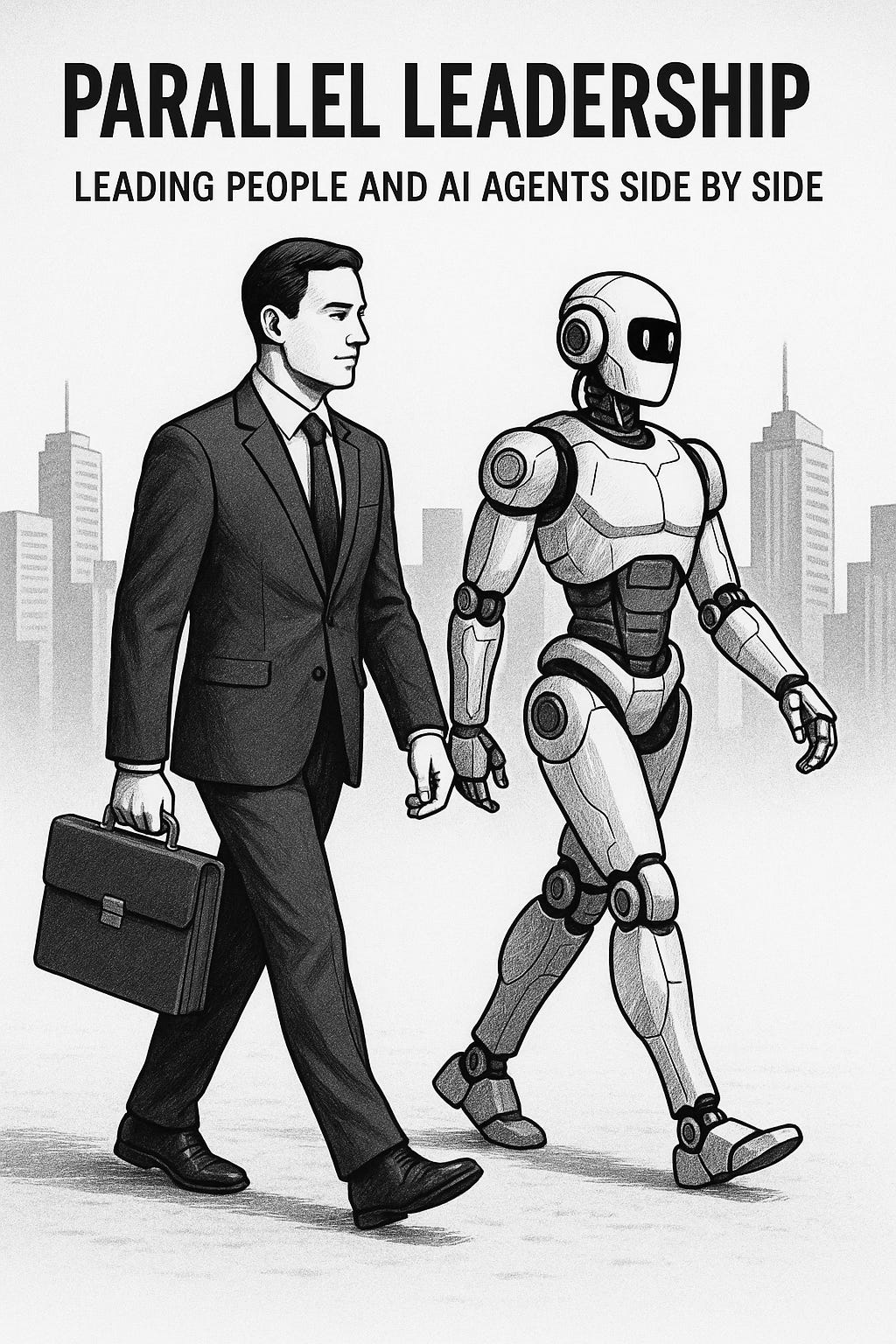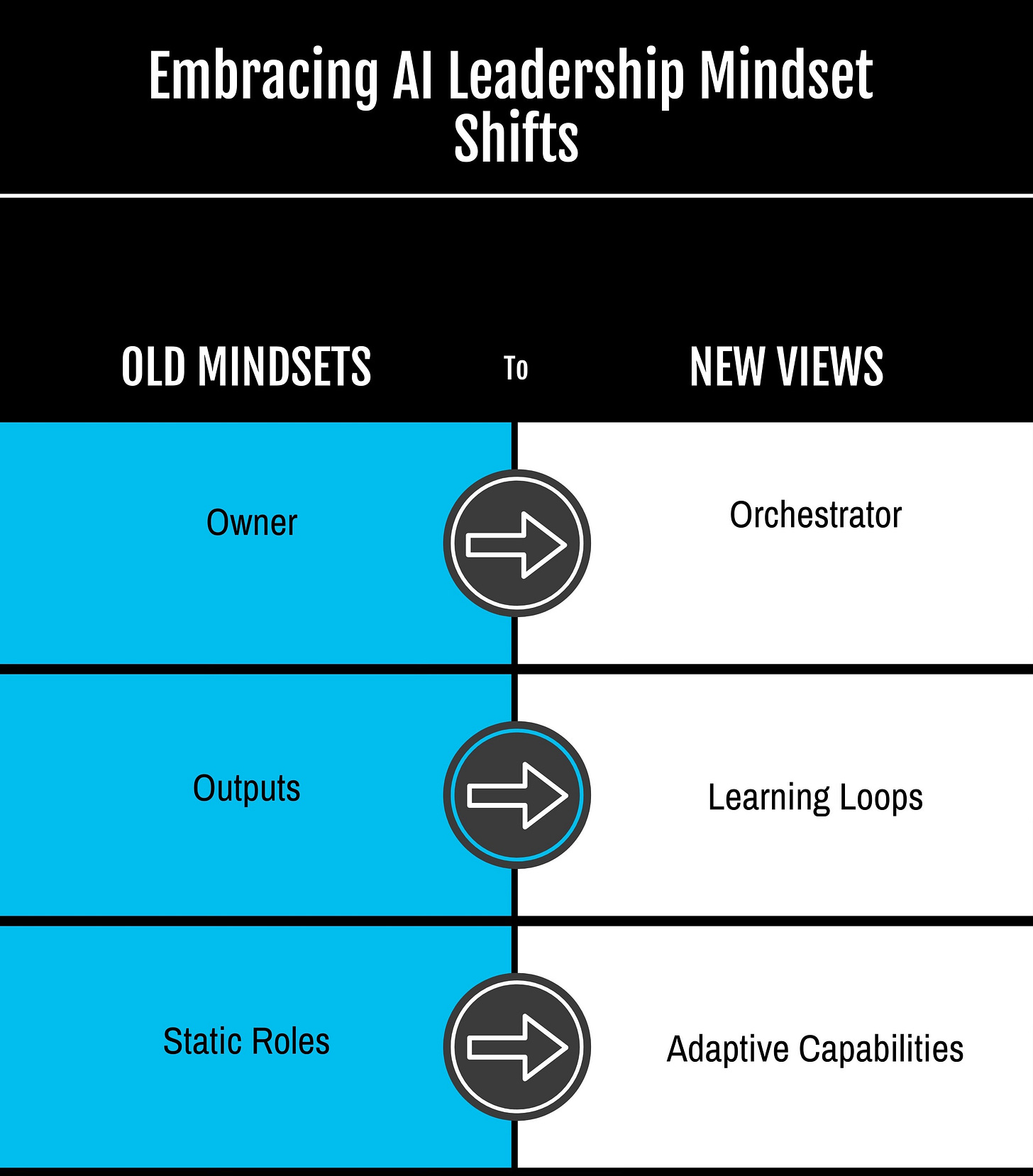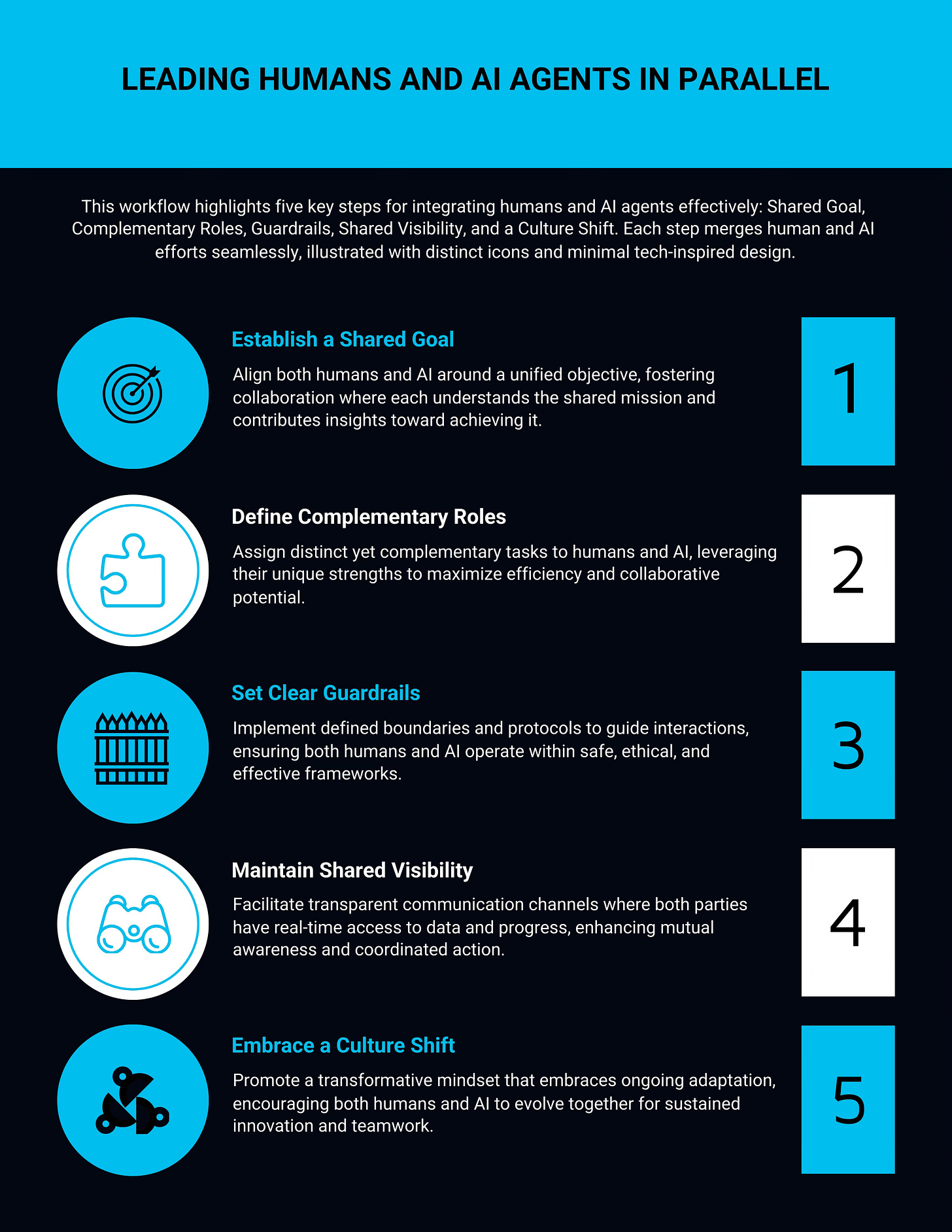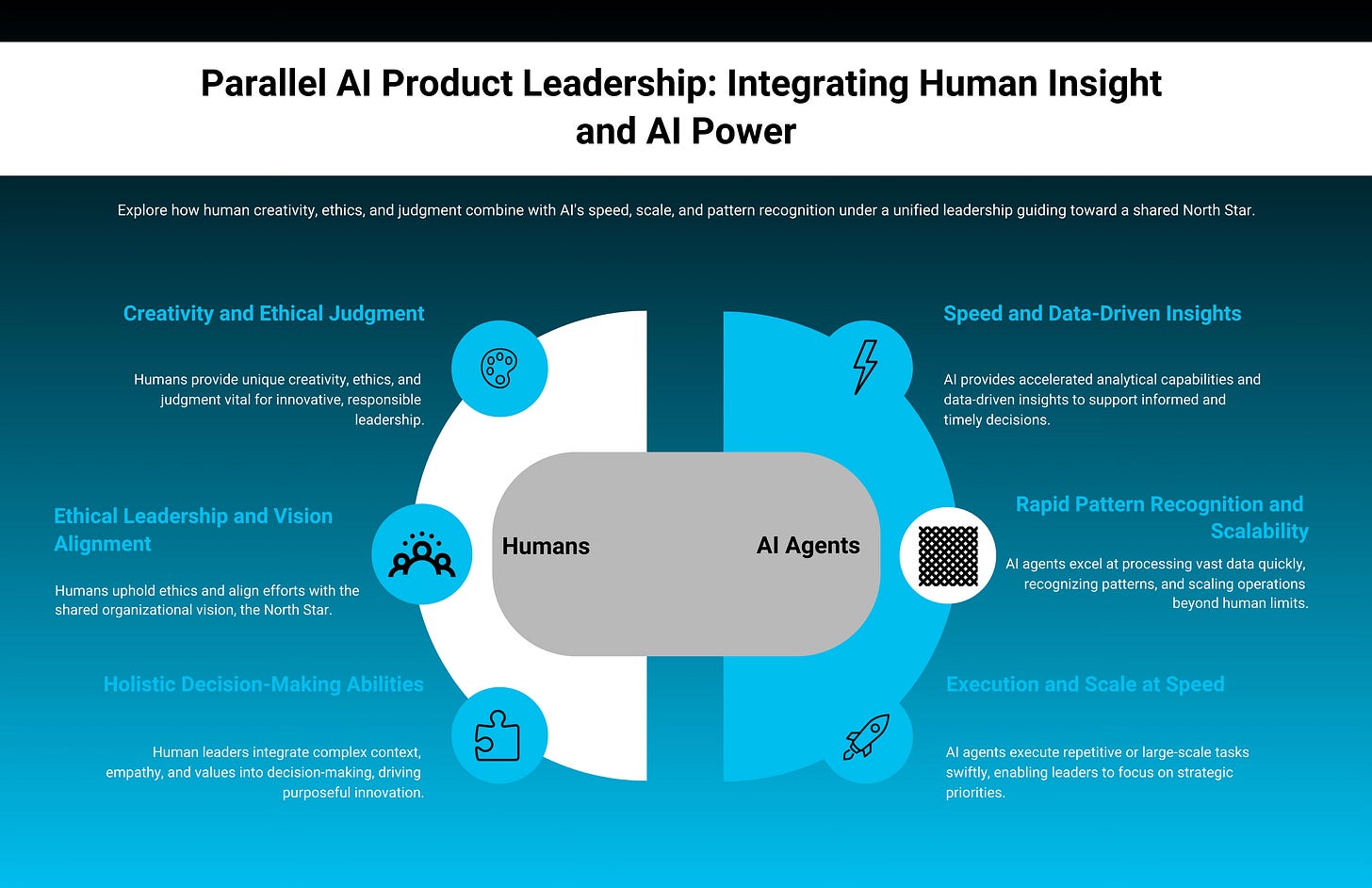Parallel Leadership: Leading people and AI agents side by side
What Great AI Product Leadership Looks Like
The first time I saw a self-driving car on the road, I was amazed how a car can drive itself. How could a car not only move on its own but also see and make decisions in real time? and then I thought about what happens when the unexpected happens, an obstacle it’s never seen, a situation that demands judgment. Could the car truly navigate that without human involvement? I was also thinking why would someone risk and trust their life with a car, but the most important thing wasn’t that they could move, it was that they still needed a steering wheel and there was someone anxiously behind waiting to take over
Everyone talks about the dream of letting go of the wheel entirely. But the real breakthrough is realizing you still need a way for a human to guide, override, and share control with the machine.
Without that, a self-driving car isn’t a transportation revolution, it’s a two-ton liability.
AI products are at the same stage right now.
We’ve proven they can “drive” on their own, especially with the recent ChatGPT 5 and Perplexity agents. The bigger question is whether we can design the controls, so humans and AI agents can work together, take the right turns, and avoid expensive collisions.
Now it’s humans and intelligent agents or humans using intelligent agents, moving at the same time, toward the same goals or in completely different directions if you don’t lead them well.
Introduction
Product leadership has always been about alignment, making sure the right people are working on the right problems in the right way. That hasn’t changed.
What’s changed is the composition of the team.
Your team might now include:
An autonomous research agent that scans and summarizes market reports overnight.
A data-cleaning bot that prepares and validates datasets before they hit a model.
A decision-making model that approves or rejects certain transactions automatically.
These AI “teammates” don’t work 9-to-5, they don’t take coffee breaks, and they don’t get tired. But they also don’t understand context, ethics, or the unspoken nuances of your product strategy, unless you lead them well.
This is why AI product leadership is now a parallel leadership challenge:
You lead human contributors, managing relationships, emotions, skill development, and collaboration.
You lead AI agents, managing training data, guardrails, feedback loops, and integration with human work.
It’s not about replacing people with machines. It’s about designing a cohesive, high-performance system where humans and AI agents each do what they do best, and where the leader has the tools and visibility to guide them both.
Why It Matters
Getting this right is beginning to seem more like a now skill than a “future skill”
Reason 1: The team of the future is already here
AI agents are already embedded in product development, marketing, operations, finance, and customer service. Even if you don’t think of them as “team members,” they are making decisions, producing outputs, and influencing customer experiences.
Reason 2: Ineffective leadership creates silent risk
An unaligned AI agent can quietly optimize for the wrong goal, cut corners, or introduce bias at scale, issues that might go unnoticed until they’re costly or public.
Reason 3: Great leadership compounds over time
When humans and AI agents work in a coordinated way, the whole system gets smarter faster. Learning loops accelerate, trust builds, and your product’s capability compounds, making it harder for competitors to catch up.
In short: AI changes the speed, scale, and stakes of product leadership.
The Three Shifts in AI Product Leadership
From my research in navigating this shift, I’ve seen three core leadership mindset changes that separate the winners from the ones who get stuck in “AI theater.”
1. From Owner to Orchestrator
In the traditional model, you own the roadmap, make the key calls, and direct the team. In the AI era, you’re less of a “project owner” and more of a conductor.
Humans and AI agents each have strengths and limits:
Humans bring creativity, judgment, empathy, and the ability to navigate ambiguity.
AI agents bring speed, scale, tireless repetition, and massive data processing.
Your goal is to arrange the “score” so these strengths complement, not compete.
If you let them work in isolation, you get dissonance. If you orchestrate them, you get harmony.
Example: In a product discovery sprint, humans might define the What, Why, hypothesis and frame experiments, while AI agents crunch historical usage data, identify patterns and generate potential test designs. Then the leader ensures both streams review output from each other before any decision is made.
2. From Outputs to Learning Loops
Classic product leadership celebrates outputs: features shipped, bugs fixed, timelines met.
AI product leadership measures something else: how quickly the system learns and improves.
A human-only team learns at a human pace, new insights might take weeks to turn into changes.
A human+AI team, well-led, can learn in days or even hours.
The unit of progress is no longer “feature” or “release”, it’s the learning loop:
Input → AI processing → Output → Human feedback → Model update → Better output
As a leader, your question becomes:
“How many high-quality learning loops did we complete this week?”
3. From Static Roles to Adaptive Capabilities
In the old world, you had fixed roles: designer, analyst, PM, engineer.
In the new world, roles can shift as AI takes on certain tasks and frees humans for others.
A customer researcher might become a human-AI workflow designer.
A business analyst might evolve into a model performance auditor or AI Judge.
Playbook: Leading Humans and AI Agents in Parallel
Here’s a sample framework to manage both human and AI contributors under a single, coherent system.
1. Align on a Shared North Star
Both humans and AI agents need to be optimizing for the same outcome.
If your team is aiming for “increase customer lifetime value” but your AI agent is optimizing for “maximize short-term conversions,” you’ll burn trust and harm the product.
Leader move: Translate the business goal into clear, measurable objectives for both humans and AI. Make the trade-offs explicit.
2. Map Complementary Roles
Reduce the need to ask “Should AI do this or should a person?” Instead, ask: “Which parts of this workflow should be human-led, AI-led, or hybrid?”
Humans excel at:
Strategic prioritization
Ethical judgment
Complex problem solving
Relationship building
AI excels at:
Data processing at scale
Repetitive and rule-based tasks
Pattern recognition in large datasets
24/7 availability
3. Build Guardrails into the Workflow
Humans self-correct based on culture, feedback, and experience. AI agents need explicit governance mechanisms:
Pre-deployment checks: Test with sandbox data and edge cases.
Live monitoring: Track accuracy, bias, and drift.
Human override: Give people the ability to pause or reverse AI decisions in high-stakes cases.
Leader move: Define “red flag” triggers for when human review is required. Build them into the workflow not as an afterthought.
4. Make the Invisible Visible
You can’t lead what you can’t see.
Leaders need dashboards that show:
What AI agents have done (tasks completed, recommendations made)
Success/error rates
Escalations to human review
Trends in performance over time
Leader move: Share these dashboards with the whole team. Transparency builds trust in the AI and in your leadership.
5. Lead the Cultural Shift
People will resist working with AI if they see it as a threat. They’ll embrace it if they see it as an amplifier of their skills.
Leader moves:
Train the team on how to collaborate with AI agents.
Make human judgment the hero, show how AI enables them to do more valuable work.
Celebrate wins where human + AI together outperform either alone.
Case Study: FinSolve’s Parallel Leadership in Action
(Name changed, based on a real example)
FinSolve, a mid-sized fintech, introduced AI agents to handle routine credit risk scoring. At first, analysts distrusted the system, assuming it would replace them.
The product leader took three steps:
Full transparency: Weekly dashboards showed both human and AI accuracy rates.
Control mechanisms: Analysts could flag and override AI outputs with no penalty.
Shared wins: Awards recognized “Best Human–AI Decision” each quarter.
Result: Within six months, analysts trusted the AI enough to let it handle 70% of cases automatically, freeing them to focus on the 30% that required deep judgment.
Skills of a Great AI Product Leader
Through my conversations, interviews and research, I’ve found the most effective leaders share these skills:
Systems Thinking – Understanding the interplay between humans, AI, data, and business objectives.
Data Literacy – Knowing what’s possible and what’s risky with data in AI systems.
Change Management – Guiding people through new and evolving ways of working.
Voice of The Customer (VoC) – Balancing innovation with customer input, needs and fairness .
Outcome Orientation – Measuring success in business impact, not tech novelty. The tag of being a tech-company alone is no longer a value proposition, value to customer is key.
30-Day Leadership Sprint
Want to start leading humans and AI agents in parallel? Here’s a 4-week starter plan:
Week 1: Audit your workflows. Identify tasks that are human-led, AI-led, and hybrid.
Week 2: Align both humans and AI on a shared set of outcome metrics.
Week 3: Introduce transparency, create a shared dashboard of AI activity and performance.
Week 4: Run a small pilot with clear guardrails and human oversight. Capture learnings and scale.
Closing Reflection
The Wright brothers didn’t just make a plane fly. They made it steerable, trustworthy, and replicable.
As AI becomes part of your product team, your role as leader is to design the controls, for the humans, for the AI agents, and for the way they work together.
The leaders who master this won’t just keep their teams in the air. They’ll take them to places no one else can reach.





